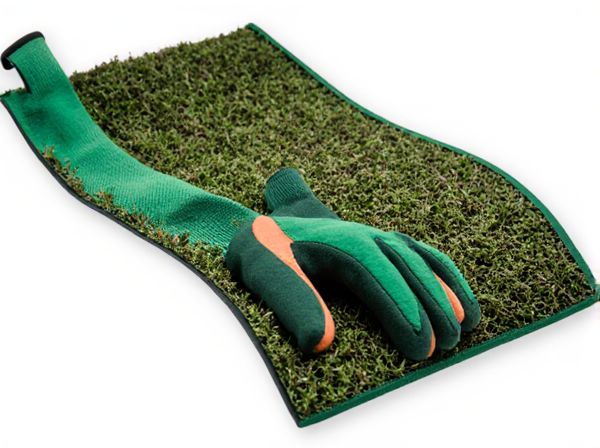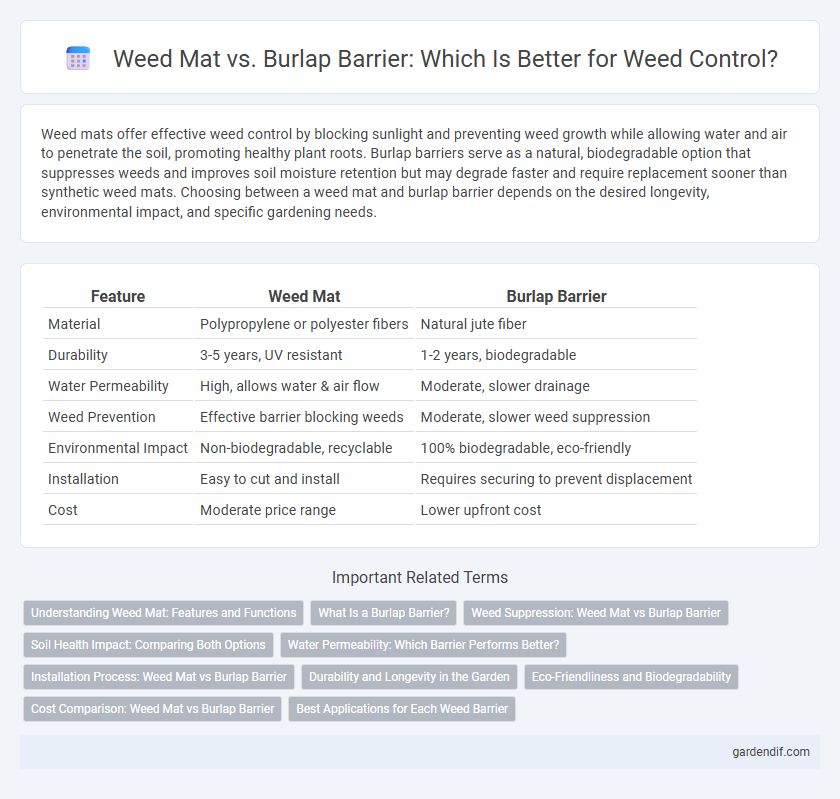
Weed Mat vs Burlap Barrier Illustration
Weed mats offer effective weed control by blocking sunlight and preventing weed growth while allowing water and air to penetrate the soil, promoting healthy plant roots. Burlap barriers serve as a natural, biodegradable option that suppresses weeds and improves soil moisture retention but may degrade faster and require replacement sooner than synthetic weed mats. Choosing between a weed mat and burlap barrier depends on the desired longevity, environmental impact, and specific gardening needs.
Table of Comparison
| Feature | Weed Mat | Burlap Barrier |
|---|---|---|
| Material | Polypropylene or polyester fibers | Natural jute fiber |
| Durability | 3-5 years, UV resistant | 1-2 years, biodegradable |
| Water Permeability | High, allows water & air flow | Moderate, slower drainage |
| Weed Prevention | Effective barrier blocking weeds | Moderate, slower weed suppression |
| Environmental Impact | Non-biodegradable, recyclable | 100% biodegradable, eco-friendly |
| Installation | Easy to cut and install | Requires securing to prevent displacement |
| Cost | Moderate price range | Lower upfront cost |
Understanding Weed Mat: Features and Functions
Weed mats, typically made from woven or non-woven polypropylene, serve as durable ground covers that block sunlight to suppress weed growth while allowing water and air permeability for healthy soil. These mats are UV-stabilized to ensure prolonged outdoor use and come in various thicknesses and densities to suit different gardening or landscaping needs. Unlike burlap barriers, weed mats offer a more consistent weed control solution by preventing root penetration and minimizing maintenance efforts.
What Is a Burlap Barrier?
A burlap barrier is a natural, biodegradable fabric used in landscaping to suppress weed growth while allowing water and air to penetrate the soil. Unlike synthetic weed mats, burlap barriers offer eco-friendly weed control by creating a physical barrier that blocks sunlight but decomposes over time, enriching the soil with organic matter. This makes burlap barriers ideal for sustainable gardening and weed prevention in flower beds, vegetable patches, and around trees.
Weed Suppression: Weed Mat vs Burlap Barrier
Weed mats provide superior weed suppression compared to burlap barriers due to their dense, non-porous structure that blocks sunlight effectively, preventing weed germination and growth. Burlap barriers, while biodegradable and environmentally friendly, allow more light and moisture to pass through, giving weeds a better chance to sprout beneath the surface. Weed mats typically offer longer-lasting weed control and require less frequent replacement, making them a more efficient choice for maintaining weed-free garden beds and landscaping areas.
Soil Health Impact: Comparing Both Options
Weed mats and burlap barriers differ significantly in their impact on soil health; weed mats, typically made from synthetic materials, effectively suppress weeds while allowing water and air penetration, promoting beneficial microbial activity and soil structure. Burlap barriers, as natural fiber options, biodegrade over time, adding organic matter to the soil and enhancing nutrient cycling, but may initially restrict water flow compared to permeable weed mats. Choosing between these options depends on balancing immediate weed control needs with long-term soil health benefits and environmental considerations.
Water Permeability: Which Barrier Performs Better?
Weed mats typically offer superior water permeability compared to burlap barriers, allowing moisture to flow through while effectively suppressing weed growth. Weed mats are designed with synthetic fibers that balance durability and drainage, preventing waterlogging and root rot. In contrast, burlap barriers, though biodegradable, may hinder water absorption due to their tighter weave and tendency to compact, potentially limiting soil aeration and moisture penetration.
Installation Process: Weed Mat vs Burlap Barrier
Weed mats offer a straightforward installation process by rolling them out directly over the soil and securing with staples or pins, providing a durable, permeable barrier against weeds. Burlap barriers require more preparation, involving cutting and fitting the material to contours, then anchoring it with stakes, which can be labor-intensive but biodegradable. Both methods effectively reduce weed growth, but weed mats are generally quicker to install and offer longer-lasting protection.
Durability and Longevity in the Garden
Weed mats typically offer superior durability and longevity compared to burlap barriers, as they are made from synthetic materials designed to withstand prolonged exposure to UV rays and moisture without breaking down. Burlap barriers, while biodegradable and eco-friendly, tend to degrade faster when exposed to garden elements, often lasting only one to two growing seasons. Gardeners seeking long-term weed control benefit from the resilience of weed mats, which maintain their structural integrity for multiple years, reducing the need for frequent replacements.
Eco-Friendliness and Biodegradability
Weed mats made from natural fibers like jute or coir offer superior eco-friendliness due to their full biodegradability, enriching soil health as they decompose. Burlap barriers, also composed of natural materials, provide similar benefits but often lack the durability of woven weed mats, requiring more frequent replacement and potentially generating more waste. Choosing biodegradable weed mats reduces plastic pollution and supports sustainable gardening by minimizing long-term environmental impact.
Cost Comparison: Weed Mat vs Burlap Barrier
Weed mat typically costs between $0.10 to $0.30 per square foot, offering a durable and reusable option for long-term weed control. Burlap barrier prices range from $0.15 to $0.40 per square foot, often selected for biodegradability but with less longevity under heavy use. Considering installation and replacement frequency, weed mats generally provide better cost efficiency over time compared to burlap barriers.
Best Applications for Each Weed Barrier
Weed mats excel in garden beds and pathways where consistent airflow and water permeability prevent soil erosion and promote healthy plant growth. Burlap barriers are ideal for temporary weed control around tree roots and shrubs, offering natural biodegradability and moisture retention. Using weed mats in vegetable gardens and burlap barriers in landscaping enhances weed management efficiency tailored to specific horticultural needs.
Weed Mat vs Burlap Barrier Infographic

 gardendif.com
gardendif.com